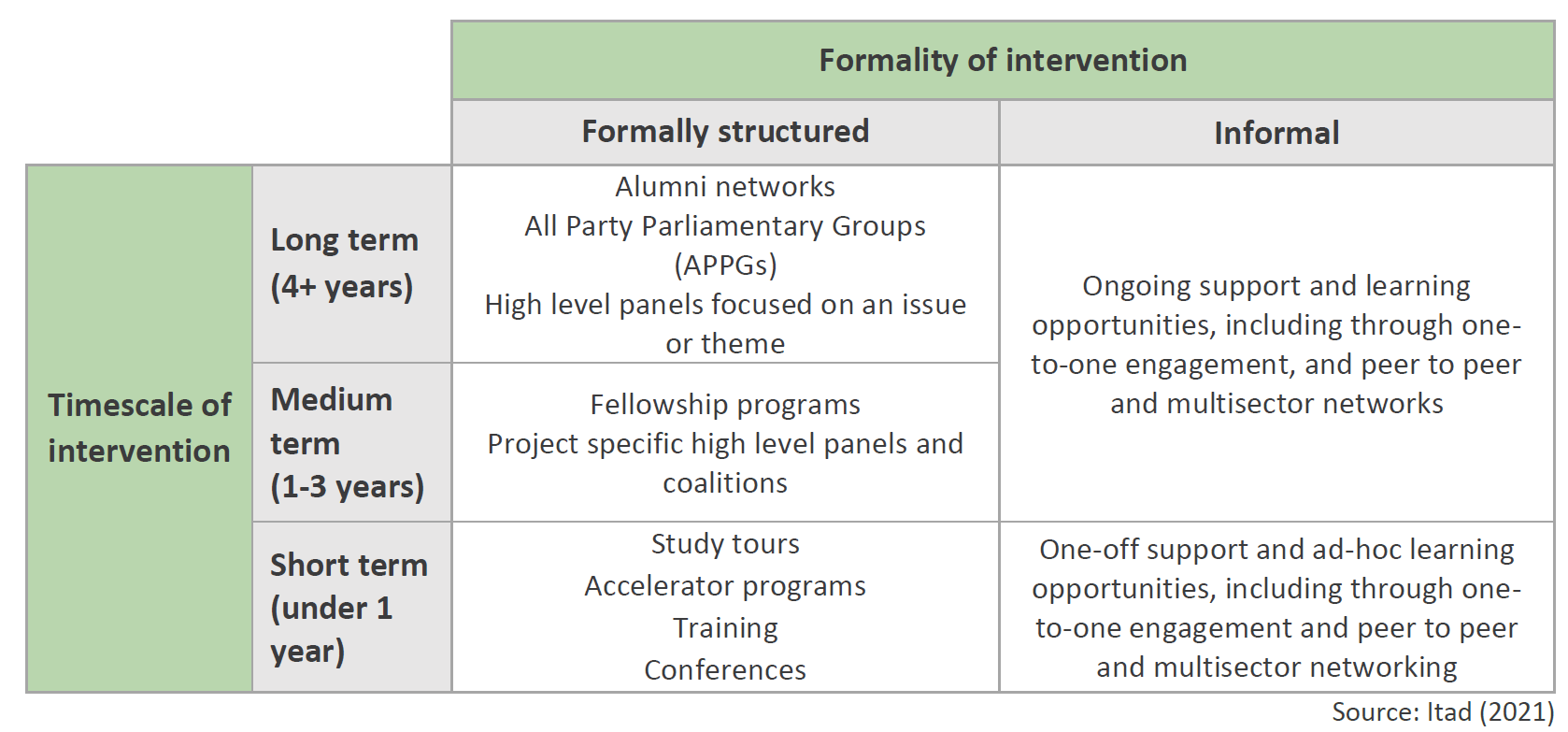Champion building involves working with individuals aligned with your own goals to influence policy decisions. So far in this series, we’ve identified what qualities a potential champion might have and discussed how to choose the best kinds of champions for your context.
We now turn to the things to keep in mind when planning champion building activities. As policy change doesn’t happen overnight, building a lasting, trusted relationship with your champions is key.
Understanding a champion’s motivation

The starting point to developing sustainable partnerships is understanding what drives someone to become a champion. Motivation can vary from being purely belief in the cause to financial, career or personal development incentives.
We identified five broad categories of benefits that champions can be motivated by. Not surprisingly, these categories also mirror the types of support that might suit different champions – something we’ll discuss in more detail later.
1. Funding and resources
Providing financial backing to champions rewards their achievement and can ensure the champion feels supported and recognised in their work.
2. Recognition
It is important to formally acknowledge champions’ role through celebrating their accomplishments and raising their profile and visibility with public and peer audiences. This can be done by engaging the media or nominating champions for leadership roles or awards.
3. Skills building
Champion building should support individuals to develop or improve a specific skill that may be needed for the role, such as public speaking or the ability to write effectively.
The emphasis should be on skills not knowledge, however, as evidence on professional development points out that the most effective interventions include an interactive component such as hands-on training rather than didactic inputs such as listening to a lecture.
4. Access
Individuals should be provided with opportunities to participate in meetings and events and interact with other influential actors by taking part in conferences and other networking spaces.
5. Relationships
Champion building offers a connection beyond purely instrumental relationships. One of our interviewees noted that a two-hour chat on the phone might not advance anything specific, but it is a mutual investment to build trust and advance the interests of both sides later on.
Tailoring a support package
The right support package will, of course, vary by champion type and ideally be tailored to each individual’s needs and timeframes. However, there are some commonalities across champion types that make it possible to group the balance of support areas outlined above.
Read more on champion commonalities in the full report
For example, subject experts, in most cases, are likely to already have the necessary research skills and content knowledge, but they may lack the resources needed to give an issue or theme priority. Others such as celebrities, those in the media, or faith leaders may have interest and commitment but lack content knowledge.
Formal or informal support
Formally structured support, such as fellowship programmers and alumni networks, are particularly likely to benefit emerging champions.
Conversely, ad-hoc or unstructured support such as training, peer learning initiatives or supporting a champion’s attendance at a conference is more suited to honing a particular skill in individuals already displaying champion characteristics.
One thing is clear though; it is often better to offer a spectrum of opportunities rather than one linear path, to allow support to respond to individual development and changing advocacy needs.
Yet, the risk of ‘champion fatigue’ is real. Asking new champions what support they will find helpful and where it will make the biggest difference will clarify expectations from the start. Being honest about the time and efforts requested of champions from the get-go can also pay dividends later on in building a long and trusting relationship
The graph below is useful in outlining types of support best suited to different timeframes.

Figure 1: Distillation of interventions by formality and timescale
Working with sceptics and opponents
Engaging ‘sceptics’ or ‘opponents’ of a particular subject particularly calls for a tailored support package. Our research highlights some guiding principles to keep in mind when approaching them to act as champions.
In a nutshell, the aim should be to encourage sceptics, while seeking to neutralise opponents.
Being realistic about expectations is key. Evidence shows sceptics can be persuaded through first-hand testimony and personal stories. The best outcome when engaging with opponents, however, is that they become less vocal in their opposition – considering how hard it is to shift people’s values and opinions.
Once you are clear about your goals, you can utilise the following tips.
- Work through others: the most common way people change their minds is by interacting with others. Work with those close to the potential champion or who have key things in common with them to make the first approach and act as persuaders.
- Depolarise the issue: position an issue as non-partisan as far as possible. Social psychologist Jonathan Haidt points to the importance of creating environments that increase similarity, not diversity, by focusing on shared goals.
- Offer something valuable: position yourself as an asset by offering information or access the champion might not otherwise have. For example, The Organization of African First Ladies for Development supports first ladies by helping coordinate funds for ‘passion’ community projects.
- Target your messaging: understand a champion’s reluctance to support particular causes and shape counterarguments that directly address them. To reach different audiences you must understand their moral frames and how best to appeal to them.
Tailoring your support to the type of champion, their needs and motivations, and the time you have by following the principles introduced above can guide you in creating partnerships that last beyond the lifetime of a particular issue.
While engaging individuals who are not aligned with your goals (one of the key characteristics of a champion) can be risky, it can also bring high rewards. Persuading someone who sits on the opposite side of the debate in the value of your advocacy can attract others to join the fight. Meaningful change needs to go beyond ‘preaching to the converted’.
We hope this blog was helpful in introducing you to the range of support that can be offered to champions so that they are motivated to engage in a long term and mutually beneficial partnership.
In our next and final blog of the series, we will explore the issue of monitoring and evaluating champion effectiveness: how do you bring it all together and demonstrate that your efforts in selecting and supporting champions have been successful.

